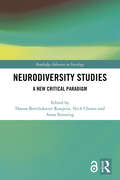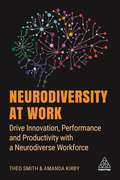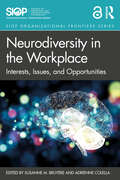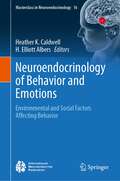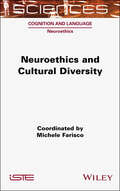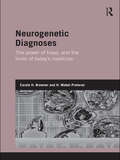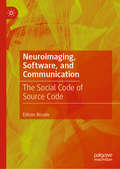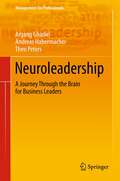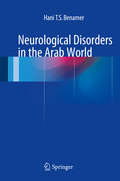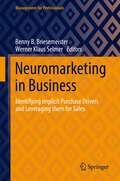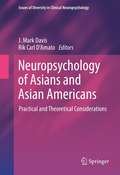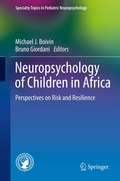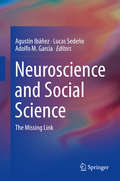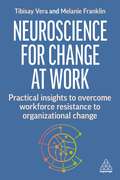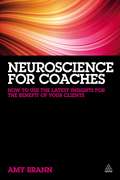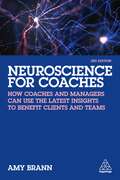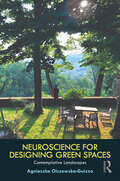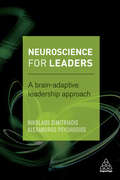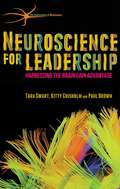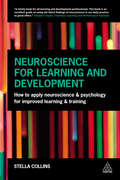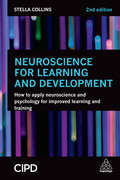- Table View
- List View
Neurodiversity Studies: A New Critical Paradigm (Routledge Advances in Sociology)
by Nick Chown Anna Stenning Hanna Bertilsdotter RosqvistBuilding on work in feminist studies, queer studies and critical race theory, this volume challenges the universality of propositions about human nature, by questioning the boundaries between predominant neurotypes and ‘others’, including dyslexics, autistics and ADHDers. This is the first work of its kind to bring cutting-edge research across disciplines to the concept of neurodiversity. It offers in-depth explorations of the themes of cure/prevention/eugenics; neurodivergent wellbeing; cross-neurotype communication; neurodiversity at work; and challenging brain-bound cognition. It analyses the role of neuro-normativity in theorising agency, and a proposal for a new alliance between the Hearing Voices Movement and neurodiversity. In doing so, we contribute to a cultural imperative to redefine what it means to be human. To this end, we propose a new field of enquiry that finds ways to support the inclusion of neurodivergent perspectives in knowledge production, and which questions the theoretical and mythological assumptions that produce the idea of the neurotypical. Working at the crossroads between sociology, critical psychology, medical humanities, critical disability studies, and critical autism studies, and sharing theoretical ground with critical race studies and critical queer studies, the proposed new field – neurodiversity studies – will be of interest to people working in all these areas.
Neurodiversity at Work: Drive Innovation, Performance and Productivity with a Neurodiverse Workforce
by Amanda Kirby Theo SmithAn organization's employees are its biggest competitive advantage. Performance gains can be achieved through cost saving, process improvement or technology adoption, but the biggest difference is made by people. This means that recruiting, engaging and retaining the very best talent has never been more important.Crucially, these employees should be a diverse group of people with different approaches, skills and strengths in problem-solving and driving innovation. As well as focusing on gender, race, age and class, it is critical that businesses also develop a neurodiverse workforce if they are committed to outperforming the competition and achieving sustainable business growth.Neurodiversity at Work is a practical guide that explains what neurodiversity is, why it's important and what the benefits are. It covers how to attract, recruit and engage neurodiverse talent and provides guidance on how to adapt HR policies, processes and workplaces to ensure that all employees, including the 2 in 10 employees in the UK who are neurodiverse, can reach their full potential. Neurodiversity at Work is packed full of case studies from leading organizations like Microsoft who are already seeing the productivity, performance and financial benefits of neurodiversity in the workplace. Individuals in these companies are also experiencing benefits in their working environments. Also featured are interviews with prominent figures in the neurodiversity community and people who have successfully adapted their HR processes for neurodiversity, including members of the ND@IBM Program and the Head of People and Culture at Autotrader. With tips, advice, examples and 'how to' actions in every chapter, this is essential reading for every HR professional.
Neurodiversity in the Workplace: Interests, Issues, and Opportunities (SIOP Organizational Frontiers Series)
by Susanne M. Bruyère Adrienne ColellaNeurodiversity in the Workplace presents a timely and needed perspective on the role and responsibility of employers and those working to increase the effectiveness of workplace practices to examine the many ways we preclude large segments of the population from employment; minimizing opportunities for building a truly inclusive work environment. This collection provides an opportunity to look at how discrimination can occur across the employment process and what can be done to minimize the exclusionary practices that prevent neurodiverse individuals from getting into the workplace, advancing, thriving, and contributing as each of us desires to do. With expertise from leading professionals, this book provides a holistic look at the application of leadership theories in a neurodiverse context and how the workplace can be adapted to accommodate for neurodiverse employees. This book also explores effective recruitment strategies by looking into applicant screening as well as interviewing and selection, adapting internal organizational resources to a neurodiverse workforce, and legal and regulatory environment considerations for autism hiring programs. Each chapter provides an overview of existing knowledge on effective workplace inclusion practices across the employment process, specific implications of research to date for a more neurodiversity-inclusive workplace, and what future research is needed to further inform these practices. This volume is intended to increase awareness about the challenges and opportunities in making the workplace more neurodiversity-inclusive, making it instrumental for I/O and other psychologists. This book is also crucial for management and business consultants; employers; diversity, equity, and inclusion specialists; human resource professionals; and others interested in neurodiversity inclusion more broadly.
Neuroendocrinology of Behavior and Emotions: Environmental and Social Factors Affecting Behavior (Masterclass in Neuroendocrinology #16)
by Heather K. Caldwell H. Elliott AlbersThis volume highlights current research on how the neuroendocrine system helps to influence emotional states and ultimately behavioral output. Social relationships and context-appropriate behavioral responses are important for the survival of most vertebrate species. These relationships can range from transient social interactions to strong social bonding between sexual partners and social behaviors can be observed and evaluated from the individual- to the group-level. Further, behavioral output is shaped by complex interactions between the physical environment, genetics, experience, and context, and are often modulated by the neuroendocrine system. In this book, experts in the field will provide a sweeping look at novel research in the neuroendocrine regulation of important behaviors ranging from parental care to social homeostasis, with a focus on comparative studies across vertebrate species. The first part of the book is dedicated to theneuroendocrinology of relationships, including the coordination of acoustic signals in songbirds, the complexity of social relationships in primates, and cooperation and parenting in humans. The second part of the book focuses on social behaviors and provides some insights into their regulation, including the neuroendocrine regulation of maternal behavior in rodents, the roles of oxytocin and vasopressin in the modulation of sex-specific social behavior, the interactions between adult neurogenesis, the neuroendocrine system and social behavior, and a consideration of neuroendocrine influences on reproductive decision making across species. The book concludes with a section on environmental influences on neuroendocrine systems underlying behavior, including how social isolation and endocrine disrupting chemicals affect the neuroendocrinology of behavior and emotions. Given its breadth, this volume is appropriate for undergraduate students, graduate students, postdoctoral researchers, and established researchers who are interested in neuroendocrinology and behavior. This is the sixteenth volume in the International Neuroendocrine Federation (INF) Masterclass in Neuroendocrinology series, which aims to illustrate the highest standards and highlight the latest technologies in basic and clinical research and aspires to provide inspiration for further exploration into the exciting field of neuroendocrinology.
Neuroethics and Cultural Diversity
by Michele FariscoThere is a growing discussion concerning the relationship between neuroethical reflections and cultural diversity, which is among the most impactful factors in shaping neuroethics, both as a scientific discipline and a social enterprise. The impacts of culture on science and its public perception are particularly relevant to neuroethics, which aims to facilitate the creation of an interface between neuroscience and society at large. Time is ripe for neuroethics to review the influence of the culturally specific contexts from which it originated (i.e. North America and Western Europe) and to also include other cultural perspectives in the discussion. This book illustrates a convergent approach among different cultures in identifying the main issues raised by neuroscience and emerging technologies. This should be taken as a starting point for advancing in the search for shared solutions, which are, if not definitive, at least sufficiently reliable to be translated into democratic deliberative processes.
Neurogenetic Diagnoses: The Power of Hope and the Limits of Today’s Medicine (Genetics and Society)
by Carole H. Browner Mabel H. PreloranAs world populations continue to age, the incidence of very common, ultimately fatal neurodegenerative diseases (some of medicine’s most puzzling illnesses) will increase exponentially. Neurogenetic Diagnoses, the Power of Hope, and the Limits of Today’s Medicine explores the diverse impacts and intense meanings of genetic diagnoses for patients suffering from such diseases, and for their family caregivers and clinicians. Through richly-textured, often heart-wrenching longitudinal case studies, Neurogenetic Diagnoses... reveals how extremely difficult it can be for patients to obtain a definitive diagnosis for the cause of their symptoms, even with genetic testing; how, with or without definitive diagnoses, patients and family caregivers strive to come to terms with their situations; and how they are aided (or not) in these endeavors by their doctors. The analysis is framed by increasingly sharp social debate over the consequences of decoding the human genome -- and the impact of genetic technology on our lives.
Neuroimaging, Software, and Communication: The Social Code of Source Code
by Edison BicudoThis book analyses the social contexts in which programmers design neuroimaging software used in brain studies. It shows that in the same way people engage in everyday communication, programmers are involved in a series of communicative processes to realize the negotiations and discussions generated by software development. In this way, highly technical activities such as computer code writing are also underpinned by values, preferences, and power relations.At the same time, the book sheds new light on scientists’ increasing dependence on software. On the one hand, many scientific tasks can no longer be performed without the help of computational technologies. On the other hand, most scientists have only superficial computing knowledge. As a result, inequalities emerge whereby some scientists take the most strategic methodological decisions whereas other scientists can only rely on the technical help provided by user-friendly computer applications.
Neuroleadership: A Journey Through the Brain for Business Leaders
by Theo Peters Argang Ghadiri Andreas HabermacherThis book takes you on a journey through the brain, its function and its impact on leadership. The young business field of neuroleadership is founded on the belief that understanding the brain can give leaders new and powerful insights into human behaviour and how to effectively tap into that knowledge to generate better returns in business. The book approaches the background, history, and major thinkers in the field, but also reassesses the fundamental concept of neuroleadership. The authors look into the fundamental basic needs of human beings, how they are represented in the neural networks, and how this manifests in motivational drives. The book also focuses explicitly on how impactful organisational tools can be from the viewpoint of the brain. By following this methodology, the reader will be able to use the knowledge of neuroscience at the workplace to better address individuals' brains and hence tap into the full power of brains in business.
Neurological Disorders in the Arab World
by Hani T. S. BenamerAfter graduating from Tripoli, Libya in 1990, Dr Benamer came to the United Kingdom in 1991 to further his training in medicine. He obtained the MRCP in 1994 and trained in neurology in Glasgow. He obtained a PhD and CCST in 2000 and was appointed a consultant neurologist in Wolverhampton and Birmingham the same year. He has been the lead neurologist in New Cross Hospital in Wolverhampton since 2006. Dr Benamer is a general neurologist with special interest in movement disorders. Dr Benamer is honorary clinical senior lecturer in Birmingham University and has an interest in medical education, in which he obtained a postgraduate certificate from Keele University in 2007. He has published more than 35 papers and two books. He is currently a senior editor of the Libyan Journal of Medicine. He was also an examiner of the MRCP Diploma from 2005 to 2009. Dr Benamer's publications relevant to the subject of the book: 1. Benamer HT. 2007. Neurological disorders in Libya: an overview. Neuroepidemiology 29:143-9 2. Benamer HT. 2008. The ancestry of LRRK2 Gly2019Ser parkinsonism. Lancet neurology 7:769-70; author reply 70-1 3. Benamer HT, de Silva R, Siddiqui KA, Grosset DG. 2008. Parkinson's disease in Arabs: a systematic review. Movement disorders: official journal of the Movement Disorder Society 23:1205-10 4. Benamer HT, Ahmed ES, Al-Din AS, Grosset DG. 2009. Frequency and clinical patterns of multiple sclerosis in Arab countries: a systematic review. Journal of the neurological sciences 278:1-4 5. Benamer HT, Grosset D. 2009. Stroke in Arab countries: a systematic literature review. Journal of the neurological sciences 284:18-23 6. Benamer HT, Grosset DG. 2009. A systematic review of the epidemiology of epilepsy in Arab countries. Epilepsia 50:2301-4 7. Benamer HT, Shakir RA. 2009. The neurology map of the Arab world. Journal of the neurological sciences 285:10-2 8. Benamer HT. 2010. Neurology expertise and postgraduate training programmes in the Arab world: a survey. European neurology 64:313-8 9. Benamer HT, de Silva R. 2010. LRRK2 G2019S in the North African population: a review. European neurology 63:321-5 10. Benamer HT, Deleu D, Grosset D. 2010. Epidemiology of headache in Arab countries. The journal of headache and pain 11:1-3 11. Benamer HT. 2011. More epidemiological studies of neurological disorders are needed in the Arab countries. Neuroepidemiology 36:70.
Neuromarketing in Business: Identifying Implicit Purchase Drivers and Leveraging them for Sales (Management for Professionals)
by Werner Klaus Selmer Benny B. BriesemeisterThis book shows how neuromarketing works in practice. It describes how companies can use the methods and insights of neuroscience to make better decisions themselves. It brings together real-world use cases in the area of applied neuroscience, collected from the globally leading consumer neuroscience companies and their clients. The use cases come from a variety of business areas, from advertising research to store design, from finding the right name for a brand to designing a compelling website. The book reveals how clients engage in neuromarketing; the business problems they can encounter, and have encountered, solving with this new approach; and the values they generate.
Neuropsychology of Asians and Asian-Americans: Practical and Theoretical Considerations
by J. Mark Davis Rik Carl D'AmatoNeuropschology with Asians and Asian Americans Practical and Theoretical Considerations J. Mark Davis and Rik Carl D'Amato, editors The challenge of cultural competence for health providers is more than the recognition of other ethnicities: it entails the balancing of group and individual factors to apply relevant information in diagnostic and therapeutic settings. Particularly in need of culturally appropriate services are Asians and Asian Americans, populations that are diverse, growing, and underserved by Asian practitioners. Neuropsychology with Asians and Asian Americans takes cultural neuroscience to new levels in its variety and usefulness. Focusing on the largest groups of Far East and Southeast Asian descent, this leading-edge reference examines the influence of culture on psychological processes and identifies sociocultural factors as they influence neurological aspects of client presentation. This expert coverage goes beyond well-known constructs of "collectivism" and "family orientation" toward establishing an evidence base crucial to understanding, assessing, and treating Asian and Asian American clients, including: Linguistic factors and language assessment of Asians.Society and acculturation in Asian and Asian American communitiesMental illness from Asian and Asian American perspectives.Understanding cognitive differences across the lifespan: comparing Eastern and Western culturesClinical interviews and qualitative assessment with Asian clientsNeuropsychological test selection with Asian clients Unique in its scope and detail, Neuropsychology with Asians and Asian Americans is a necessary resource for neuropsychologists and rehabilitation specialists as well as social workers and clinical, counseling, and school psychologists.
Neuropsychology of Children in Africa
by Bruno Giordani Michael J. BoivinIncreasingly, global humanitarian efforts are focusing on improving the lives of children. And among the developing world, the African nations are particularly affected by extreme weather conditions, devastating pandemics, and armed conflict. Neurocognitive science offers significant avenues toward bringing needed aid to the continent while creating a template for helping children worldwide. The studies in Neuropsychology of Children in Africa clearly illustrate how the brain develops and adjusts in the face of adversity. Contributors span assessment approaches and public health risk factors, and represent established topics and emerging lines of research, including biocultural constructs and genomic technologies. Together, these chapters argue for methodology that is culturally sensitive, scientifically rigorous, consistent, and sustainable. And although the focus is pediatric, the book takes a lifespan approach to prevention and intervention, modeling a universal framework for understanding neurocognitive development. Included in the coverage: Assessment of very young children in Africa in the context of HIV.Psychosocial aspects of malnutrition among African children.Assessment of neuropsychological outcomes in pediatric severe malaria.Neurodisability screening using the Ten Questions questionnaire.The neuropsychology of sickle cell disease in West African children.Computerized Cognitive Rehabilitation Therapy for African children. As a guide to current findings or a springboard for new studies, Neuropsychology of Children in Africa is a necessary reference for researchers, policymakers, and diverse professionals in global aid organizations, and across the discipline.
Neuroscience and Critique: Exploring the Limits of the Neurological Turn
by Ed Pluth Jan De VosRecent years have seen a rapid growth in neuroscientific research, and an expansion beyond basic research to incorporate elements of the arts, humanities and social sciences. It has been suggested that the neurosciences will bring about major transformations in the understanding of ourselves, our culture and our society. In academia one finds debates within psychology, philosophy and literature about the implications of developments within the neurosciences, and the emerging fields of educational neuroscience, neuro-economics, and neuro-aesthetics also bear witness to a 'neurological turn' which is currently taking place. Neuroscience and Critique is a ground-breaking edited collection which reflects on the impact of neuroscience in contemporary social science and the humanities. It is the first book to consider possibilities for a critique of the theories, practices, and implications of contemporary neuroscience. Bringing together leading scholars from several disciplines, the contributors draw upon a range of perspectives, including cognitive neuroscience, critical philosophy, psychoanalysis, and feminism, and also critically examine several key ideas in contemporary neuroscience, including: The idea of "neural personhood" Theories of emotion in affective neuroscience Empathy, intersubjectivity and the notion of "embodied simulation" The concept of an "emo-rational" actor within neuro-economics. The volume will stimulate further debate in the emerging field of interdisciplinary studies in neuroscience, and will appeal to researchers and advanced students in a range of disciplines including critical psychology, philosophy, and critical studies.
Neuroscience and Education: A Philosophical Appraisal (Routledge International Studies in the Philosophy of Education)
by Clarence W. JoldersmaThis volume makes a philosophical contribution to the application of neuroscience in education. It frames neuroscience research in novel ways around educational conceptualizing and practices, while also taking a critical look at conceptual problems in neuroeducation and at the economic reasons driving the mind-brain education movement. It offers alternative approaches for situating neuroscience in educational research and practice, including non-reductionist models drawing from Dewey and phenomenological philosophers such as Martin Heidegger and Merleau-Ponty. The volume gathers together an international bevy of leading philosophers of education who are in a unique position to contribute conceptually rich and theoretically framed insight on these new developments. The essays form an emerging dialogue to be used within philosophy of education as well as neuroeducation, educational psychology, teacher education and curriculum studies.
Neuroscience and Social Science
by Agustín Ibáñez Lucas Sedeño Adolfo M. GarcíaThis book seeks to build bridges between neuroscience and social science empirical researchers and theorists working around the world, integrating perspectives from both fields, separating real from spurious divides between them and delineating new challenges for future investigation. Since its inception in the early 2000s, multilevel social neuroscience has dramatically reshaped our understanding of the affective and cultural dimensions of neurocognition. Thanks to its explanatory pluralism, this field has moved beyond long standing dichotomies and reductionisms, offering a neurobiological perspective on topics classically monopolized by non-scientific traditions, such as consciousness, subjectivity, and intersubjectivity. Moreover, it has forged new paths for dialogue with disciplines which directly address societal dynamics, such as economics, law, education, public policy making and sociology. At the same time, beyond internal changes in the field of neuroscience, new problems emerge in the dialogue with other disciplines.Neuroscience and Social Science – The Missing Link puts together contributions by experts interested in the convergences, divergences, and controversies across these fields. The volume presents empirical studies on the interplay between relevant levels of inquiry (neural, psychological, social), chapters rooted in specific scholarly traditions (neuroscience, sociology, philosophy of science, public policy making), as well as proposals of new theoretical foundations to enhance the rapprochement in question.By putting neuroscientists and social scientists face to face, the book promotes new reflections on this much needed marriage while opening opportunities for social neuroscience to plunge from the laboratory into the core of social life. This transdisciplinary approach makes Neuroscience and Social Science – The Missing Link an important resource for students, teachers, and researchers interested in the social dimension of human mind working in different fields, such as social neuroscience, social sciences, cognitive science, psychology, behavioral science, linguistics, and philosophy.
Neuroscience for Change at Work: Practical Insights to Overcome Workforce Resistance to Organizational Change
by Melanie Franklin Tibisay VeraHow do I communicate change to the business? How do I maintain productivity and wellbeing during change? How do I deal with resistance to business change?Neuroscience for Change at Work answers these questions and explains how to use insights from neuroscience when designing change and communicating it to employees. It is based on the PEPE model which outlines the four fundamental principles that drive resistance to change in individuals, teams and the wider organization. This book provides specific coverage of how neuroscience can inform change initiatives in remote, hybrid and in-person working environments to ensure successful business transformation in any working model. There is also discussion of how change can impact employee mental health and wellbeing and explains how using insights from neuroscience can help to safeguard this. There is also discussion of how to handle competing priorities from different groups of employees during times of business change. Every chapter of Neuroscience for Change at Work is supported by practical examples, tips, tools and case studies as well as robust, evidence-based insights from neuroscience. Co-authored by a neuroscientist with extensive experience in applying neuroscience to business transformation projects, this book is a practical guide for all change managers and anyone responsible for employee engagement, wellbeing and productivity during times of change.
Neuroscience for Coaches
by Amy BrannThe world of coaching is competitive. Organisations want coaches who deliver results, and can prove it. Many coaching tools and techniques are now fairly well established - but how do they actually work? The coach who can answer this question credibly and convincingly is sought after. This ground-breaking book equips coaches with cutting edge neuroscience information that will help them deliver greater value to their clients. It covers the foundations that coaches need to be aware of and crucially, the ways they can use this new information effectively and practically in their everyday work. Readers will strengthen their kitbag of coaching tools and will be able to explain to their clients the neurological underpinning of the techniques they are using. No forward-thinking coach can afford to be ignorant of recent scientific developments: Neuroscience for Coaches will give them the practical knowledge they need.
Neuroscience for Coaches: How coaches and managers can use the latest insights to benefit clients and teams
by Amy BrannMany coaching tools and techniques are now well established, but how do they actually work? The third edition of Neuroscience for Coaches answers this question to help coaches and managers deliver greater value to clients and employees.Based on extensive research, Neuroscience for Coaches provides a clear explanation of the aspects of neuroscience that are relevant to coaching so coaches can describe to clients why particular techniques work and the benefits to be gained from using them. It also features interviews with Marshall Goldsmith, Susan Grandfield, Christian van Nieuwerburgh and Kim Morgan on topics including mindfulness and behaviour change in coaching.This fully updated third edition covers the latest neuroscientific research on key brain areas and their functions, such as the Prefrontal cortex and Amygdala which affect attention, processing and emotional regulation. With tips and insights throughout, it crucially demonstrates the ways in which coaches and managers who coach can use this information effectively and practically in their everyday work. Neuroscience for Coaches is a vital resource for improving coaching practice with the latest scientific developments, tools and techniques.
Neuroscience for Coaches: How to Use the Latest Insights for the Benefit of Your Clients
by Amy BrannMany coaching tools and techniques are now fairly well established, but how do they actually work? Neuroscience for Coaches equips coaches with information that will help them answer this question and therefore deliver greater value to clients. Based on over twelve years of research, this book provides a clear explanation of the aspects of neuroscience that are relevant to coaching so you can describe to clients from a neuroscientific perspective why particular techniques and methods work and the benefits to them.This fully updated 2nd edition of Neuroscience for Coaches includes new interviews with Marshall Goldsmith, Susan Greenfield, Christian van Nieuwerburgh and Kim Morgan, along with new material on oxytocin, goals and mindfulness. It covers the latest neuroscientific research and, crucially, the ways in which coaches can use this information effectively and practically in their everyday work. Neuroscience for Coaches is a vital resource for keeping up to date with recent scientific developments, tools and techniques in coaching.
Neuroscience for Designing Green Spaces: Contemplative Landscapes
by Agnieszka Olszewska-GuizzoUrban parks and gardens are where people go to reconnect with nature and destress. But do they all provide the same benefits or are some better than others? What specific attributes set some green spaces apart? Can we objectively measure their impact on mental health and well-being? If so, how do we use this evidence to guide the design of mentally healthy cities? The Contemplative Landscape Model unveils the path to answer these questions. Rooted in landscape architecture and neuroscience, this innovative concept is described for the first time in an extended format, offering a deep dive into contemplative design and the science behind it. In the face of the global mental health crisis, and increasing disconnection from nature, design strategies for creating healthier urban environments are what our cities so sorely need. This book delves into the neuroscience behind contemplative landscapes, their key spatial characteristics, and practical applications of the Contemplative Landscape Model through case studies from around the world. Landscape architects, urban planners, students, land managers, and anyone interested in unlocking the healing power of landscapes will find inspiration here.
Neuroscience for Leaders: A Brain Adaptive Leadership Approach
by Dr Nikolaos Dimitriadis Dr Alexandros PsychogiosTo behave more productively in complex business situations, we need to understand and alter the inner workings of our brain. With insight from applied neuroscience, behavioural economics and psychology, the brain can be retrained and become our most valuable asset. Neuroscience for Leaders takes a practical approach and offers an easy-to-implement framework for making the behavioural changes to become a more effective leader. Drawing on research and practical experience, the authors present a flexible framework for fine-tuning the leadership brain. The Brain Adaptive Leadership approach is a step-by-step guide to enhancing the way you think, understanding and nurturing emotions, shaping automated brain responses, and developing dynamic relations. Neuroscience for Leaders explains both the underlying science and how to apply its findings in business, demonstrating why and how you can become a better leader through brain-based learning. With tools, managerial tips and clear actions to implement the method straight away, Neuroscience for Leaders is an invaluable companion to managers and leaders who want to gain the brain edge.
Neuroscience for Leaders: Practical Insights to Successfully Lead People and Organizations
by Dr Nikolaos Dimitriadis Dr Alexandros PsychogiosUnlock your potential with the latest neuroscientific insights and succeed as a leader in complex business environments.As understanding of neuroscience increases, it is better understood how scientific insights can be applied to develop and enhance leadership. Neuroscience for Leaders captures the most up-to-date and important findings in neuroscience and links these to the business world. This guide offers a simple framework to put these principles into practice to make better decisions, take the right actions and find faster solutions.Now in its second edition, this book presents a comprehensive approach to leading people and organizations based on academic research. The authors' 'Brain Adaptive Leadership' approach offers a step-by-step guide to enhancing the way leaders think, understanding and nurturing emotions, shaping automated brain responses and developing dynamic relationships. Examples, activities and practical suggestions are all designed to be clear and engaging. Neuroscience for Leaders is the essential guide for leaders who are ready to gain the business advantage scientifically.
Neuroscience for Leadership: Harnessing the Brain Gain Advantage (The Neuroscience of Business)
by Paul Brown Kitty Chisholm T. SwartLeadership can be learned: new evidence from neuroscience clearly points to ways that leaders can significantly improve how they engage with and motivate others. This book provides leaders and managers with an accessible guide to practical, effective actions, based on neuroscience.
Neuroscience for Learning and Development
by Stella CollinsNeuroscience for Learning and Development is about the psychology and neuroscience that underpins effective and successful training and learning. It introduces the latest research and concepts and suggests practical tools, techniques and ideas to improve how trainers train and how people learn. Readers will find new and more effective ways of working and will discover a sound basis for good practice. They will also discover the research that backs up what they are already doing well and evidence to support future projects and plans in order to make a convincing case to budget holders. Neuroscience for Learning and Development covers the design and delivery of face-to-face, online and virtual learning as well as how to create environments which make learning easier. It provides evidence to stop training and learning being seen as 'soft and fluffy' and will help trainers and L&D teams persuade the rest of their organization of their value. This book explains the science behind creative training delivery so that learners will be motivated, enjoy training, pay attention, remember what they learn and be able to apply it back at work. It explains the neuroscience of attention, memory and habits and how to make sure people learn what they need to learn. Readers will be able to distinguish the neuromyths from the neuroscience and will find out which elements of brain science offer evidence for current practice and as well as discovering new ideas to continue to develop their skills and practice.
Neuroscience for Learning and Development: How to Apply Neuroscience and Psychology for Improved Learning and Training
by Stella CollinsIn order to design and deliver effective Learning and Development (L&D) initiatives, it is essential to understand how our brains work to learn, process and retain information. Neuroscience for Learning and Development introduces the latest research and concepts in the field, equipping learning and development and training professionals with an understanding of some of the inner workings of the mind. Covering areas such as how to create effective learning environments, promoting motivation and how to make learning 'stickier' through using stories and narratives, this book offers practical tools and ideas that can be applied in a variety of contexts, from training sessions and coaching conversations, to lectures and presentations. Featuring insights from L&D practitioners who have applied such approaches in practice, readers will not only find new techniques to implement right away, but also discover the research that backs up what they are already doing well, enabling them to make convincing cases to budget holders.This updated second edition of Neuroscience for Learning and Development contains new chapters on digital learning and the importance of rest and sleep, as well as updated wider content and new material on mindfulness, learning through your senses, and the neuroscience of habits.
